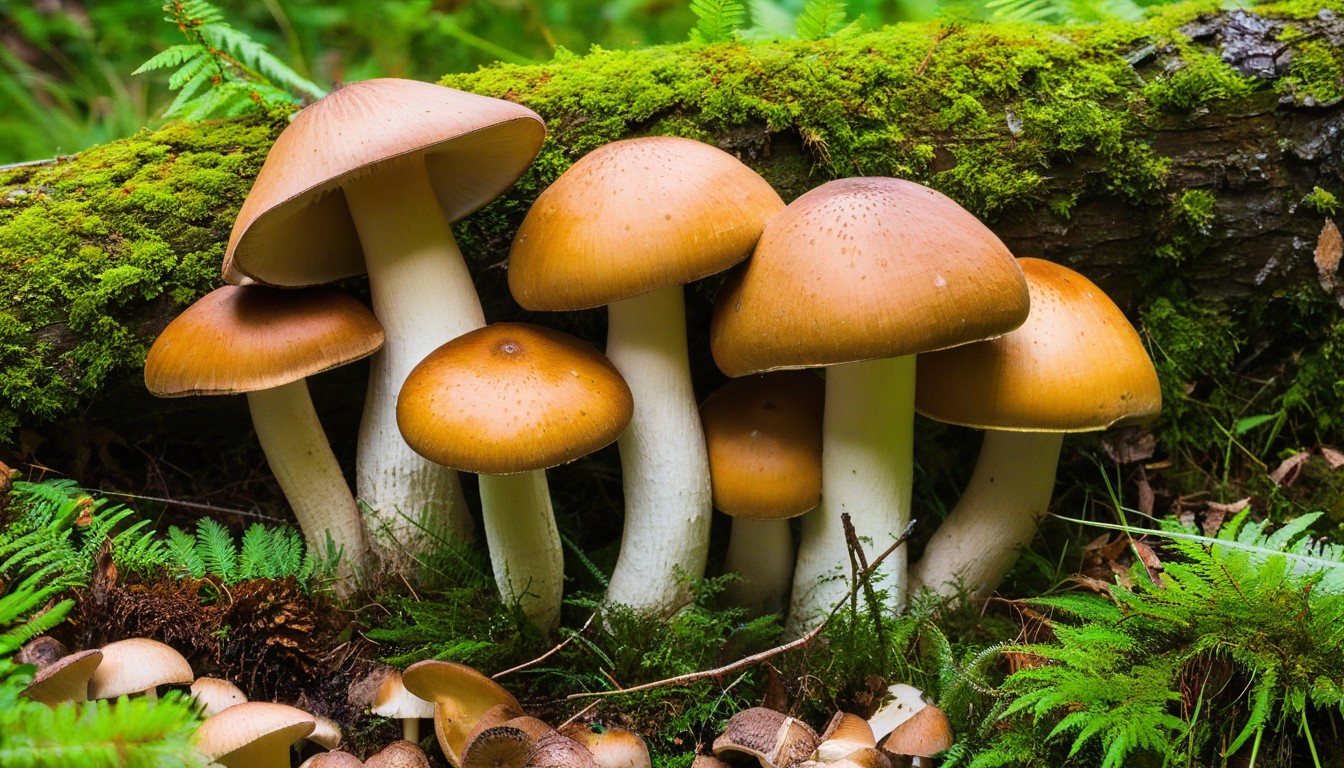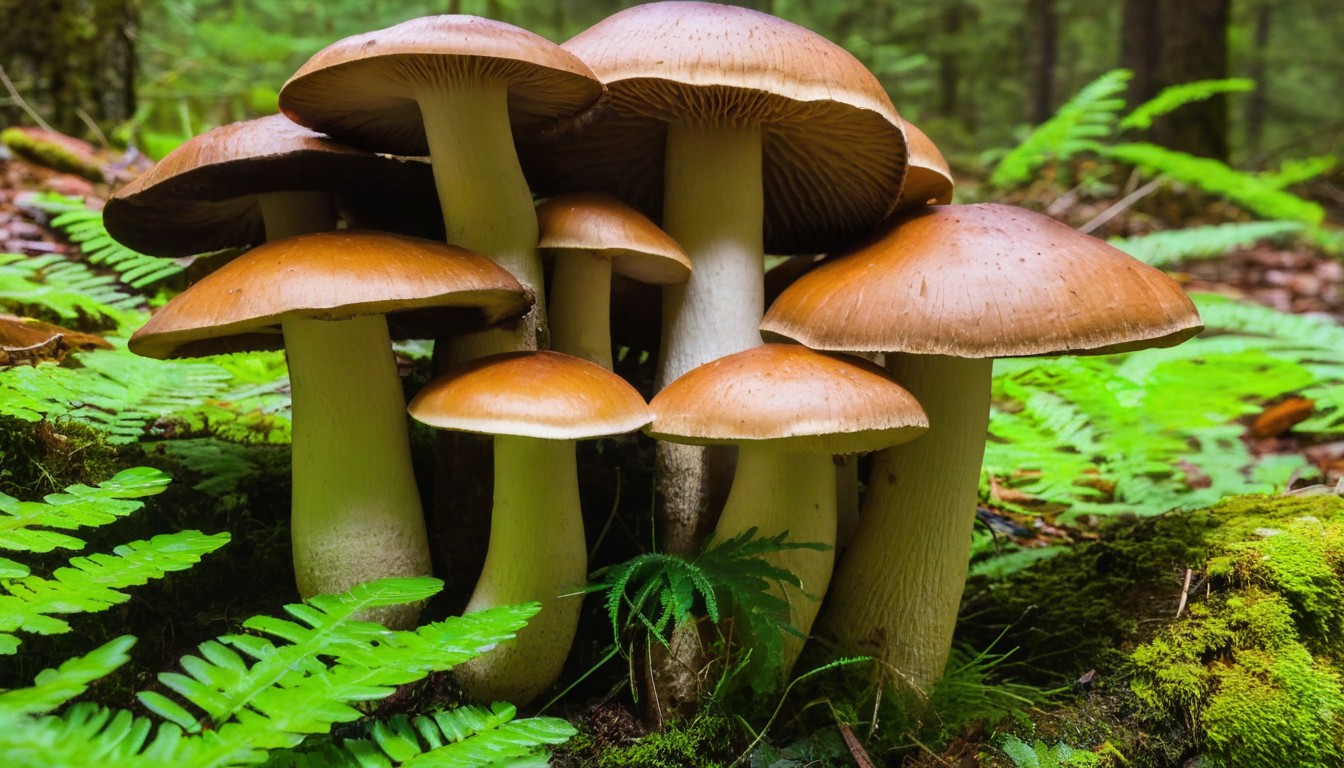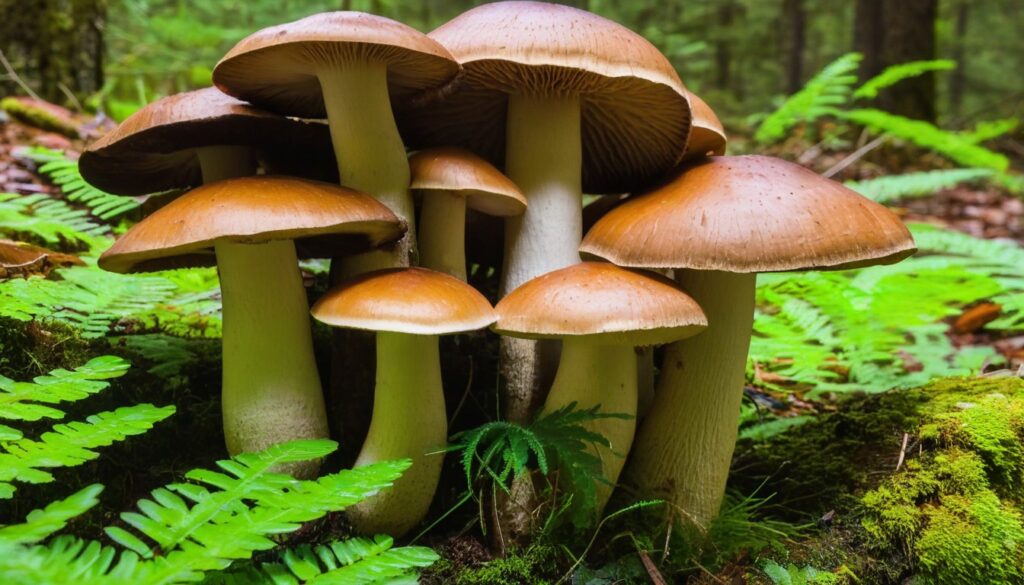There’s nothing quite like the thrill of foraging for Porcini mushrooms in the stunning wilderness of Oregon. With its ideal climate and fertile soil, Oregon is home to some of the most bountiful Porcini hunting grounds in the world. These deliciously rich and meaty mushrooms are a favorite among chefs and food enthusiasts alike, prized for their earthy flavor and unique texture.
Key Takeaways
- Porcini mushrooms are a highly sought-after culinary treasure in the Pacific Northwest region of the United States.
- Oregon’s temperate climate, abundant rainfall, and rich soil make it an ideal location for Porcini mushroom foraging.
- Identifying Porcini mushrooms requires careful observation of their distinct characteristics and features
- The best Porcini foraging spots in Oregon include national forests, state parks, and lesser-known areas with bountiful harvests.
- Practicing sustainable foraging techniques is crucial to protect the environment and ensure the longevity of Porcini mushroom populations in Oregon.
The Fascination of Porcini Mushrooms
Porcini mushrooms are a culinary treasure, praised for their earthy flavor and meaty texture. Chefs and food enthusiasts alike are captivated by their versatility and culinary potential.
But what makes Porcini mushrooms so unique and fascinating? For one, their rich and robust flavor profile can impart depth and complexity to a variety of dishes, from hearty stews to savory pasta dishes. Their meaty texture and umami flavor also make them a popular vegetarian substitute for meat in many recipes.
Porcini mushrooms are also shrouded in mystery and intrigue, as they are not easily farmed and are typically foraged for in the wild. Their scarcity and prized flavor have even earned them the nickname “king of mushrooms.”
Ultimately, the fascination of Porcini mushrooms lies in their captivating flavor, versatility, and elusive nature. For mushroom enthusiasts, it’s a joy and a privilege to discover these hidden treasures in the wild, and to savor their unique flavors in delicious and creative dishes.
The Perfect Climate in Oregon
Oregon’s climate provides the ideal conditions for the growth of Porcini mushrooms. Known for its maritime climate, the state experiences warm summers and moderate winters, with average temperatures ranging between 50°F to 77°F. The region also receives abundant rainfall, with an annual average of up to 150 inches in some areas, ensuring that the soil remains moist and fertile. These factors create the perfect environment for the growth of Porcini mushrooms, resulting in a high yield of top-quality mushrooms that are sought after by chefs and mushroom enthusiasts alike.
Besides providing optimal Porcini growth conditions, Oregon’s climate also makes for a pleasurable foraging experience. With mild temperatures and lush vegetation, mushroom hunters can enjoy exploring the beautiful landscapes of the state while on the hunt for these prized fungi. The unique combination of Oregon’s climate and geography creates a sense of adventure and discovery that you won’t find in many other locations.
Identifying Porcini Mushrooms
Porcini mushrooms are a highly sought after delicacy among chefs and mushroom enthusiasts for their meaty texture and earthy flavor. Identifying these mushrooms in the wild can be a daunting task, but with a little knowledge, it becomes easier to spot them.
The most distinguishing feature of Porcini mushrooms is their cap, which ranges in color from reddish-brown to dark brown. The cap can be smooth or slightly scaly and typically measures 2-10 inches in diameter. The underside of the cap is covered in small, white pores that release spores when mature.
The stem of the Porcini is firm and central, with a diameter of 1-3 inches. It is thick and sturdy with a fleshy texture, and typically, a white base that becomes brownish as it extends upwards.
Porcini mushrooms have a distinct nutty, sweet or spicy aroma that becomes more intense when cooked. They grow in clusters, mostly around conifers, hardwoods, or birch trees.
It is crucial to avoid mistakenly identifying dangerous look-alike mushrooms, such as the toxic Boletus satanabroth, which has a scaly stem and a dark blue color.It is also important to be aware of the specific season and location to find Porcini mushrooms. They usually grow in the late summer and early autumn in the Pacific Northwest region and prefer damp soil or ex-tree growing, near water sources.
Remember to be cautious and seek help from an expert if you are unsure about the identification of Porcini mushrooms or any other wild mushrooms.
Prime Porcini Foraging Spots in Oregon

Oregon is a forager’s paradise with its lush forests and rich soil, offering numerous prime porcini foraging spots. Whether you are a seasoned forager or a beginner, these locations are sure to provide an excellent mushroom hunting experience.
Location | Features |
|---|---|
Mount Hood National Forest | Boasts a variety of porcini mushrooms, including the highly sought-after King Bolete. |
Siuslaw National Forest | Home to a diversity of porcini mushrooms, situated near the coast and providing a stunning backdrop for your foraging experience. |
Crater Lake National Park | The perfect foraging spot during the late summer and early fall for porcini mushrooms near the crater’s edge. |
Willamette National Forest | Known for its abundant porcini mushrooms and multiple trails suitable for foraging with family and friends. |
Jerry’s Flat on the Umpqua National Forest | An area known for its high yield of porcini mushrooms and the friendly community of foragers and campers. |
Other great porcini foraging spots in Oregon include the Tillamook State Forest, the Deschutes National Forest, and the Rogue River-Siskiyou National Forest. Keep in mind that porcini mushroom foraging requires permits in some hard-to-reach areas of the state, like the Cascade-Siskiyou National Monument.
With so many wonderful options to choose from, you will be sure to find the perfect porcini foraging spot in Oregon. Happy mushroom hunting!
Seasonal Considerations for Successful Porcini Mushroom Foraging in Oregon
Porcini mushroom foraging in Oregon requires a good understanding of seasonal changes and weather patterns. The best time to find these treasures is in late summer, early fall, and early winter.
In late summer, Porcini can be found in high elevations in the forest, particularly around areas with Douglas fir and pine trees. Early fall has an ample harvest, especially after the first heavy rain, Lowland areas with oak and maple trees are often good places to search, as well as along rivers and streams, and in marshy areas.
In early winter, a fresh harvest is possible after significant rainfall in lowland areas. For the most successful foraging, check the weather forecast for rain and aim to forage one to two days after the rain. During the winter months, black truffles can also be found in the same areas as Porcini.
It is also important to consider the weather conditions while foraging for Porcini mushrooms in Oregon. Ideally, foraging should take place during the dry periods that follow a rainy spell. Dry weather will encourage the growth of the mushrooms, making them more abundant and easier to find. A cloudy and humid day can make foraging more challenging, as it encourages the growth of other mushroom species and can also cause Porcini to rot more quickly.
Overall, keep a close eye on the weather forecast, as well as the local terrain and environment, to enhance your chances of finding and harvesting Porcini successfully.
Essential Tools and Equipment

To enjoy a fruitful and safe Porcini mushroom foraging trip in Oregon, it is crucial to arrive with the proper tools and equipment. Below are the essential items to bring along:
Item | Purpose |
|---|---|
Mushroom knife | Specially designed for mushroom harvesting, mushroom knives have a curved blade for precision cutting without damaging the roots or nearby vegetation. |
Basket or bag | A sturdy container to hold and transport the harvested mushrooms safely, allowing air circulation to prevent moisture buildup. |
Field guide | A comprehensive mushroom identification guidebook or an app to help you identify and differentiate Porcini mushrooms from look-alike species and poisonous varieties. |
Proper clothing | Wear comfortable, weather-appropriate clothing and footwear that can withstand damp and rugged conditions. It’s also recommended to wear bright colors to prevent getting lost in the forest. |
With these essential tools in hand, you can take on the exciting adventure of Porcini mushroom foraging in Oregon with confidence, comfort, and safety in mind.
Sustainable Foraging Practices

Foraging Porcini mushrooms is a fun and rewarding activity that can also help the environment when done sustainably. To ensure that future generations can enjoy the same experiences, it is important to adopt sustainable foraging practices.
Proper Harvesting Techniques
Harvest Porcini mushrooms by cutting the stem rather than pulling them out of the ground, which can damage the mycelium and prevent future growth. Only take what you need, leaving some mushrooms to mature and spread their spores. When harvesting, always use a mushroom knife to avoid accidentally removing other vital organisms and leaving behind debris that could harm the environment.
Respect the Environment
While foraging, always respect the natural environment by sticking to designated trails and areas to reduce your impact on the ecosystem. Also, avoid disturbing wildlife habitats and other plant life. Make sure you collect your rubbish and all non-biodegradable waste to preserve the natural beauty of Oregon’s forests.
Ethical Considerations
Foragers must consider the ethical implications of the activity. Always obtain proper permission from landowners before foraging and be respectful of other foragers’ areas. Avoid overharvesting, as this poses a risk of depleting the mushroom population. Share your knowledge and experience with others so that they can also develop a passion for sustainable foraging.
Sustainable Foraging Techniques
Practice | Description |
|---|---|
Leave No Trace | Take all your waste and rubbish with you to preserve the environment you enjoyed while foraging. |
Respect Nature | Stick to trails and designated foraging areas to prevent unnecessary damage to the surrounding ecosystem. |
Harvest Respectfully | Use a mushroom knife to cut the stem of each mushroom, leaving some to mature and spread their spores and avoid disturbing other vital organisms. |
Ethical Considerations | Always obtain proper permission before foraging, don’t over-harvest, and share your knowledge and experience with others. |
In conclusion, sustainable foraging practices are essential to preserving Oregon’s beautiful landscapes, ensuring that future generations, and other mushroom enthusiasts can continue to enjoy the Porcini mushroom’s unique flavor and texture.
Cooking and Preserving Porcini Mushrooms

After a successful Porcini mushroom foraging trip, it’s time to savor the rewards by exploring the delicious recipes and preserving methods available. Here are some recipe ideas and techniques for cooking and preserving Porcini mushrooms:
Porcini Mushroom Risotto
One of the most popular dishes that Porcini mushrooms are used in is Risotto. This creamy and delicious dish allows the earthy flavor of Porcini mushrooms to shine through. For this recipe, you will need:
- 1 1/2 cups Arborio rice
- 4 cups chicken or vegetable broth
- 1 cup dry white wine
- 1 oz dried Porcini mushrooms
- 1 cup freshly grated Parmesan cheese
- 2 shallots, minced
- 2 cloves garlic, minced
- 2 tbsp butter
- 2 tbsp extra virgin olive oil
- Salt and pepper, to taste
Begin by soaking the dried Porcini mushrooms in hot water for about 20 minutes. Heat a large skillet over medium-high heat and add the butter and olive oil. Once hot, sauté the shallots and garlic for 2-3 minutes, until fragrant. Add the Arborio rice and stir constantly for 1-2 minutes. Add the white wine and stir until the liquid has been absorbed. Add the chicken or vegetable broth, one cup at a time, until the rice is tender. Drain the soaked Porcini mushrooms and chop them into small pieces. Add the Porcini mushrooms and grated Parmesan cheese to the skillet and stir well to combine. Cook for an additional minute, until heated through. Season with salt and pepper as desired.
Porcini Mushroom Soup
This comforting soup is perfect for chilly autumn days. Here’s what you’ll need:
- 1 lb fresh Porcini mushrooms, chopped
- 4 cups chicken or vegetable broth
- 1 onion, chopped
- 2 cloves garlic, minced
- 4 tbsp butter
- 1 cup heavy cream
- Salt and pepper, to taste
In a large soup pot, melt the butter over medium-high heat. Add the chopped onion, garlic, and Porcini mushrooms, and sauté for 5-7 minutes, until softened. Add the broth and bring to a boil. Reduce heat and simmer for 20-25 minutes, until the mushrooms are tender. Use an immersion blender or transfer the soup to a blender to purée until smooth. Return the soup to the pot and stir in the heavy cream. Heat the soup over low heat until heated through. Season with salt and pepper as desired.
Preserving Porcini Mushrooms
There are many preservation methods available for Porcini mushrooms. You can dry them, freeze them, or preserve them in oil or vinegar. Here’s a quick guide:
- Drying: Slice the Porcini mushrooms and spread them out in a single layer on a baking sheet. Place the baking sheet in a warm, dry area and let the mushrooms air dry for several days, until completely dry and brittle. Store in an airtight container.
- Freezing: Clean and slice the Porcini mushrooms. Place the mushrooms in a freezer-safe container or bag and freeze for up to 6 months.
- Preserving in Oil: Clean and slice the Porcini mushrooms. Place the mushrooms in a jar and cover with olive oil. Add garlic and herbs as desired. Store in the refrigerator for up to 3 weeks.
- Preserving in Vinegar: Clean and slice the Porcini mushrooms. Place the mushrooms in a jar and cover with white wine vinegar. Add garlic and herbs as desired. Store in the refrigerator for up to 3 weeks.
With these recipe ideas and preservation methods, you can enjoy the delicious and nutritious Porcini mushrooms all year round!
Safety Precautions and Risks
Foraging for Porcini mushrooms in Oregon can be a rewarding experience, but it’s important to take safety precautions to avoid the potential risks associated with mushroom gathering. Some risks include exposure to toxic plants, wildlife encounters, and steep, rugged terrain.
When identifying Porcini mushrooms, it’s crucial to know the difference between edible and poisonous species. Many wild mushrooms look similar, and sometimes toxic look-alike species grow alongside Porcinis.
If you’re new to foraging, it’s best to go with someone who has experience or take a class to learn how to identify mushrooms correctly. Never consume unidentified mushrooms, even if they resemble Porcinis.
Using a basket to collect mushrooms instead of a plastic bag ensures that they don’t become damaged and release spores, which can negatively impact future harvests. It’s also important to be respectful to the environment by avoiding overharvesting and leaving behind small or immature mushrooms to mature for future foragers.
Porcini Foraging Safety Tips: | Risks to Consider: |
|---|---|
|
|
Whether you’re a seasoned forager or a beginner, taking the necessary safety precautions and being aware of the potential risks can help ensure your mushroom foraging trip is safe, successful, and enjoyable.
Conclusion
Foraging for Porcini mushrooms in Oregon is an unforgettable experience that combines the thrill of the hunt with the rewards of savory, earthy flavors. With its ideal climate, abundant natural resources, and breathtaking beauty, Oregon is the perfect destination for mushroom enthusiasts and food lovers alike.
By following sustainable foraging practices, identifying prime mushroom spots, and equipping yourself with the right tools and knowledge, you can enjoy a safe and successful Porcini mushroom foraging trip in Oregon.
Whether you’re an experienced forager or a curious beginner, the breathtaking landscapes and culinary treasures of Oregon are waiting to be discovered. So pack your bags, grab your mushroom knife, and embark on a journey of adventure and delight!
FAQ
What makes Porcini mushrooms fascinating?
Porcini mushrooms are known for their earthy flavor, meaty texture, and popularity among chefs and mushroom enthusiasts.
Why is Oregon a perfect climate for Porcini mushroom foraging?
Oregon’s temperate climate, abundant rainfall, and rich, fertile soil make it an ideal location for Porcini mushroom growth.
How can I identify Porcini mushrooms?
Look for Porcini mushrooms with a distinctive appearance, pleasant scent, and specific characteristics. Proper identification techniques are essential.
Where are the prime Porcini foraging spots in Oregon?
Visit national forests, state parks, and lesser-known areas to find the best Porcini mushroom hunting locations in Oregon.
What are the seasonal considerations for Porcini foraging in Oregon?
Timing is crucial. Pay attention to the seasons, weather conditions, and key indicators to enhance your chances of success during Porcini mushroom hunting.
What tools and equipment do I need for Porcini foraging?
Carry mushroom knives, baskets, field guides, and suitable clothing for a successful Porcini mushroom foraging trip in Oregon.
How can I practice sustainable foraging for Porcini mushrooms?
It’s important to protect the environment and ensure the longevity of Porcini mushroom populations. Adopt sustainable harvesting techniques, follow ethical considerations, and respect the ecosystem.
What are some cooking and preserving methods for Porcini mushrooms?
Explore delicious recipe ideas and techniques for cooking Porcini mushrooms. Learn various methods for preserving their flavor and extending their shelf life.
What safety precautions should I take while foraging for Porcini mushrooms?
Be aware of potential risks, poisonous look-alike species, and proper handling and storage guidelines to ensure your safety during Porcini mushroom hunting.

